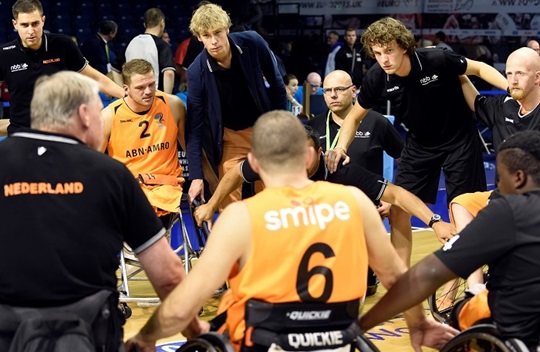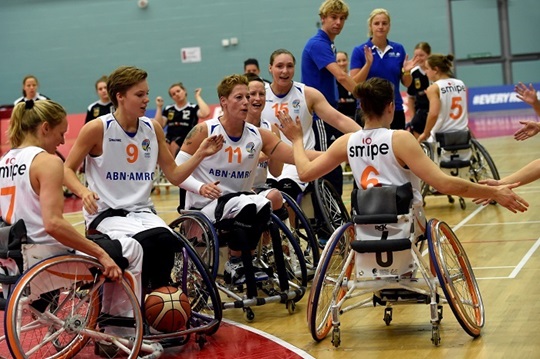In Paralympic sports, barriers aren’t necessarily visible. That’s why understanding your identity is key to know your limits. So says Toine Klerks, team manager of Dutch wheelchair basketball teams.
What does it take to win a medal in international sport?
Before we get to the answer, let me tell you my story. I manage the Dutch wheelchair basketball teams. Don’t be fooled by the wheelchair element: this is not a sport for the fainthearted. It is a very close relation to wheelchair rugby and you might know what the Americans call that: murder ball. It’s a fast and furious game that, like all sport, requires an enticing combination of skill, physical courage and quick thinking.
Before we get to the answer, let me tell you my story. I manage the Dutch wheelchair basketball teams. Don’t be fooled by the wheelchair element: this is not a sport for the fainthearted. It is a very close relation to wheelchair rugby and you might know what the Americans call that: murder ball. It’s a fast and furious game that, like all sport, requires an enticing combination of skill, physical courage and quick thinking.

Identity is key – not just in sports
Both our men’s and women’s teams qualified for the Paralympic Games in Rio in summer 2016. It was an incredible experience. The atmosphere, in the Village, around the city and, most importantly in the stadium, was utterly inspiring. It was my first time at the Games and it went way beyond what I was expecting.
There were cheering capacity crowds of 15,000 and huge drama in all the matches. The time, effort and hard work the players had put in really paid off. The end result for us was a bronze medal. It was wonderful to come away with a tangible reward and we were then even more fired up for next time: we wanted that gold.
So back to my question: what does it take to win a medal in international sport? I have a very simple view. A major part of it is identity. My experience is in Paralympic sport but this applies across all sport, and indeed across any form of work. It is all about being yourself, understanding your strengths and weaknesses, and working with your team to be the best you can be.
Both our men’s and women’s teams qualified for the Paralympic Games in Rio in summer 2016. It was an incredible experience. The atmosphere, in the Village, around the city and, most importantly in the stadium, was utterly inspiring. It was my first time at the Games and it went way beyond what I was expecting.
There were cheering capacity crowds of 15,000 and huge drama in all the matches. The time, effort and hard work the players had put in really paid off. The end result for us was a bronze medal. It was wonderful to come away with a tangible reward and we were then even more fired up for next time: we wanted that gold.
So back to my question: what does it take to win a medal in international sport? I have a very simple view. A major part of it is identity. My experience is in Paralympic sport but this applies across all sport, and indeed across any form of work. It is all about being yourself, understanding your strengths and weaknesses, and working with your team to be the best you can be.

Breaking down mental barriers to achieve full potential
Where Paralympic sports stands apart is that the examples are often very stark. Take one of our youngest players. She found bone cancer in her leg when she was 11. She was a footballer and volleyball player, and dreamed of playing at Ajax. But after the tumour was discovered she knew the dream was over. She was – and is – perfectly able to walk but just couldn’t do her talent for sport justice. It was devastating for her. It took a lot of persuasion to encourage her to sit in a wheelchair. Who would, by choice? But once she accepted it, she suddenly had the freedom to be the sportsperson she could be. She had a great debut at the Paralympics and impressed everyone.
We also have an athlete who lost both his legs in Afghanistan as a result of friendly fire. It is unimaginable for those of us fortunate enough not to have witnessed what he has. But he is mentally very tough and basketball has given him the perfect outlet for his physical strength and sporting prowess. He is very clear that it has helped him rebuild his life.
Where Paralympic sports stands apart is that the examples are often very stark. Take one of our youngest players. She found bone cancer in her leg when she was 11. She was a footballer and volleyball player, and dreamed of playing at Ajax. But after the tumour was discovered she knew the dream was over. She was – and is – perfectly able to walk but just couldn’t do her talent for sport justice. It was devastating for her. It took a lot of persuasion to encourage her to sit in a wheelchair. Who would, by choice? But once she accepted it, she suddenly had the freedom to be the sportsperson she could be. She had a great debut at the Paralympics and impressed everyone.
We also have an athlete who lost both his legs in Afghanistan as a result of friendly fire. It is unimaginable for those of us fortunate enough not to have witnessed what he has. But he is mentally very tough and basketball has given him the perfect outlet for his physical strength and sporting prowess. He is very clear that it has helped him rebuild his life.

True limitations are psychological, not physical
There are plenty of reasons to learn about disabled sport. At the top of the list sits the inspirational personal stories. I’ve given you just two and I have as many as there are people in the teams.
While these experiences apply to people who have physical disabilities, we all have barriers to overcome, one way or another. These are what give us the parameters within which we define ourselves and we can choose how much we push against them to achieve our full potential.
The key thing is to learn exactly what that potential is. To do that, we need to understand our identity and how far we’re prepared to go to achieve what we can: the true limitations are psychological, not physical.
All photos except Rio 2016 by Mathilde Dusol. Rio 2016 photo via Basketball Experience NL.
About HARTMANN's 200-year anniversary
In 2018, HARTMANN is celebrating its 200-year anniversary. We are now counting down to our anniversary celebration in June 2018 through a series of articles that show how our employees and partners contribute to advancing healthcare, as well as discussing trends and issues that affect the healthcare systems we serve.
There are plenty of reasons to learn about disabled sport. At the top of the list sits the inspirational personal stories. I’ve given you just two and I have as many as there are people in the teams.
While these experiences apply to people who have physical disabilities, we all have barriers to overcome, one way or another. These are what give us the parameters within which we define ourselves and we can choose how much we push against them to achieve our full potential.
The key thing is to learn exactly what that potential is. To do that, we need to understand our identity and how far we’re prepared to go to achieve what we can: the true limitations are psychological, not physical.
All photos except Rio 2016 by Mathilde Dusol. Rio 2016 photo via Basketball Experience NL.
About HARTMANN's 200-year anniversary
In 2018, HARTMANN is celebrating its 200-year anniversary. We are now counting down to our anniversary celebration in June 2018 through a series of articles that show how our employees and partners contribute to advancing healthcare, as well as discussing trends and issues that affect the healthcare systems we serve.
